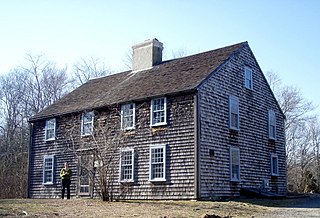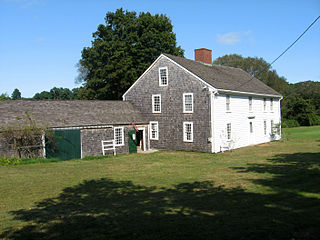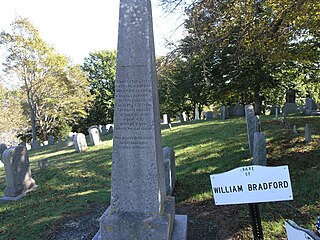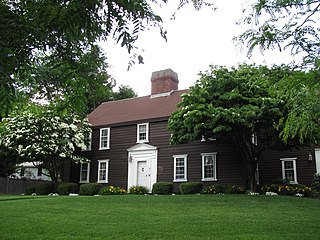
The William Briggs Homestead is an historic farmhouse at 1470 Turner Street in Auburn, Maine. Built in 1797 by one of the area's early settlers, it is one of Auburn's oldest surviving buildings. It was listed on the National Register of Historic Places in 1986.

The Harlow Old Fort House is a First Period historic house at 119 Sandwich Street in Plymouth, Massachusetts.

The Old County Courthouse is an historic court house on Leyden Street and Market Street in the Town Square of Plymouth, Massachusetts. Built in 1749, the two-story wood-frame building is believed to be the oldest wooden courthouse in the United States; it stands on the site of the first courthouse built by Plymouth Colony settlers, and may incorporate elements of a 1670 building. The site was originally the site of Edward Winslow's first house in Plymouth.

The Plymouth Village Historic District is a historic district encompassing part of the area of earliest settlement of the Plymouth Colony in Plymouth, Massachusetts. It includes properties in an area roughly bounded on the west by North Street, on the north by Water Street on the east by Town Brook, and on the south by Court Street and Main Street. The area includes Leyden Street and streets that were laid out as early as 1633, and nearby are some of Plymouth's oldest surviving houses. The site is near Plymouth Rock where the Pilgrims landed in 1620 and the Pilgrim Hall Museum containing many of their surviving artifacts.

The Jabez Partridge Homestead is an historic farmstead at 81 Partridge Road in Gardner, Massachusetts. With its oldest part dating to about 1772, it is one of the oldest buildings in the town, built by an early settler, and is a good example of Federal period architecture. It was listed on the National Register of Historic Places in 1979.

The John and Priscilla Alden Family Sites is a National Historic Landmark consisting of two separate properties in Duxbury, Massachusetts, United States. Both properties are significant for their association with John Alden, one of the settlers of the Plymouth Colony who came to North America on board the Mayflower, and held numerous posts of importance in the colony. Alden and his relationship with Priscilla Mullins were memorialized by Henry Wadsworth Longfellow in The Courtship of Miles Standish, a fictionalized narrative poem that made the story a piece of American folklore.

The Cushing Homestead is a historic house at 210 East Street in Hingham, Massachusetts. The home is a 2+1⁄2-story rear saltbox, and has traces of both 17th-century English style as well as later 18th-century Georgian. The two rooms that originally made up the house look much today as they likely did before the house was later enlarged.

Wing Fort House is a historic house at Spring Hill Road in East Sandwich, Massachusetts, located within the Spring Hill Historic District.

Fort Hill Historic District is a historic district roughly on South Street between Lyman to Monroe in Northampton, Massachusetts.

Burial Hill is a historic cemetery or burying ground on School Street in Plymouth, Massachusetts. Established in the 17th century, it is the burial site of several Pilgrims, the founding settlers of Plymouth Colony. It was listed on the National Register of Historic Places in 2013.
Harlow House may refer to:

First Parish Church in Plymouth is a historic Unitarian Universalist church at the base of Burial Hill on the town square off Leyden Street in Plymouth, Massachusetts. The congregation was founded in 1620 by the Pilgrims in Plymouth. The current building was constructed in 1899.

The Hammond House is an historic house located at 9 Old Orchard Road in the village of Chestnut Hill in Newton, Massachusetts. With an estimated construction date of 1645-1730, it is believed to be the oldest house in Newton. It is also a rare example of a First Period house that was started as a single cell, that was expanded to five bays later in the First Period; such expansion usually took place later in the 18th century, during the Georgian period. The house has been extended multiple times over the intervening centuries; the original core now lies just east of the main entrance. The original house was built by Hon. Ebenezer Stone when he moved from the Stone homestead at Mount Auburn in Watertown.

The Hatch Homestead and Mill Historic District encompasses two properties associated with the locally prominent Hatch family on Union Street in Marshfield, Massachusetts. It includes an early Georgian colonial house, and a 19th-century water-powered mill, both located on sites that had seen similar use since the 17th century. The district was listed on the National Register of Historic Places in 2009.

The Brewster Homestead is a historic house at 306 Preston Road in Griswold, Connecticut. Built about 1740, it is one of the oldest surviving buildings in the town. The house was owned by six generations of the Brewster family, and originally was the centerpiece of a farmstead of 250 acres (100 ha). The house was listed on the National Register of Historic Places in 2000 by Ron and Kate Bauer.

The Abijah Richardson Sr. Homestead is a historic house at 359 Hancock Road in Dublin, New Hampshire. Built about 1795, it is one of Dublin's oldest houses, built by Abijah Richardson Sr., one of the town's early settlers and progenitor of a locally prominent family. The house was listed on the National Register of Historic Places in 1983.
This article attempts to list the oldest houses built in the Commonwealth of Massachusetts, United States from settlement to 1659. The first immigrant houses built in the Plymouth and Massachusetts Bay colony are known as first generation structures. These were built upon settlement (1620) until about 1660 “when the first immigrant generation of preponderantly younger settlers had come to full maturity". While dozens of existing homes are thought to have been built before 1660, proving their age scientifically is another matter. Just one example built during this time period known as the Fairbanks House has been proven through dendrochronology. The rest of the examples are approximate and based on architectural studies and historical records. Its estimated that only 5 houses in total have been documented enough to firmly establish they were built during this time period. Only First Period houses built prior to 1660 are suitable for inclusion on this list as construction methods changed circa 1660. All entries should include citation with reference to: 17th century architectural features; a report by an architectural historian; or dendrochronology whenever possible.


















